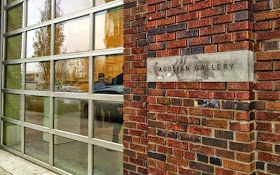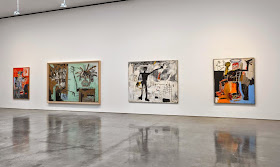B
JEAN-MICHEL BASQUIAT AT GAGOSIAN GALLERY NEW YORK
February 7th, 2013 – April 6th, 2013
JEAN MICHEL BASQUIAT AT GAGOSIAN GALLERY
February 7th, 2013 – April 6th, 2013
Gagosian Gallery is pleased to announce a major exhibition
of works by Jean-Michel Basquiat.
Featuring over fifty works from public and private
collections, the exhibition spans Basquiat’s brief but meteoric career, which
ended with his death at the age of twenty-seven. Thirty years after Larry
Gagosian first presented his work in Los Angeles, twenty years after the first
posthumous survey at the Whitney Museum of American Art (1992–93), and eight
years after the Brooklyn Museum of Art retrospective (2005), viewers will have
a fresh opportunity to consider Basquiat’s central role in his artistic
generation as a lightning rod and a bridge between cultures.
Basquiat left his family home in Brooklyn at the age of
fifteen and took to the streets. A voracious autodidact, he quickly became a
denizen of the explosive and decadent New York underground scene—a noise
musician who loved jazz, and a street poet who scrawled his sophisticated
aphorisms in Magic Marker across the walls of downtown Manhattan, copyrighting
them under the name SAMO. In 1981, he killed off this alter ego and began
painting, first on salvaged materials then later on canvas, and making
bricolage with materials scavenged from the urban environment. From the outset
he worked compulsively. He sold his first painting in 1981, and by 1982,
spurred by the Neo-Expressionist art boom, his work was in great demand. In
1985, he was featured on the cover of The New York Times Magazine in connection
with an article on the newly exuberant international art market. It was
unprecedented for an African-American artist, and for one so young. In that
photograph, Basquiat is a vision of cool, sprawled in a chair in front of one
of his bold paintings in an elegant three-piece suit and tie, with bunched
dreadlocks and bare feet.
Charismatic image aside, Basquiat was a unique and prodigious artistic talent, fusing drawing and painting with history and poetry to produce an artistic language and content that was entirely his own, and which enunciated alternative histories, such as Discography (1982), Brothers Sausage (1983), and Revised Undiscovered Genius of the Mississippi Delta (1983). Combining the tools of graffiti (Magic Marker, spray enamel) with those of fine art (oil and acrylic paint, collage, and oil stick), his best paintings maintain a powerful tension between opposing aesthetic forces—expression and knowledge, control and spontaneity, savagery and wit, urbanity and primitivism—while providing acerbic commentary on the harsher realities of race, culture, and society. In vividly colored canvases, forceful, schematic figures and menacing, masklike faces are inscribed against fields jostling with images, signs, symbols, and words used like brushstrokes. The frenetic, allover quality of many of the large works suggests a drive towards a sort of disjunctive mapping rather than the building of a classically unified composition, where seemingly unrelated marks suddenly coalesce in syncopated rhythms—like the best experimental jazz.
Charismatic image aside, Basquiat was a unique and prodigious artistic talent, fusing drawing and painting with history and poetry to produce an artistic language and content that was entirely his own, and which enunciated alternative histories, such as Discography (1982), Brothers Sausage (1983), and Revised Undiscovered Genius of the Mississippi Delta (1983). Combining the tools of graffiti (Magic Marker, spray enamel) with those of fine art (oil and acrylic paint, collage, and oil stick), his best paintings maintain a powerful tension between opposing aesthetic forces—expression and knowledge, control and spontaneity, savagery and wit, urbanity and primitivism—while providing acerbic commentary on the harsher realities of race, culture, and society. In vividly colored canvases, forceful, schematic figures and menacing, masklike faces are inscribed against fields jostling with images, signs, symbols, and words used like brushstrokes. The frenetic, allover quality of many of the large works suggests a drive towards a sort of disjunctive mapping rather than the building of a classically unified composition, where seemingly unrelated marks suddenly coalesce in syncopated rhythms—like the best experimental jazz.
Basquiat’s iconography reflects the precocious breadth of
his inspirations and preoccupations—from classical poetry to human anatomy,
from sport to music, from politics to philosophy, from the arts of Africa to
Picasso, de Kooning, and Rauschenberg. Obnoxious Liberals (1982) and Baby Boom (1982) suggest an angry
bohemian’s pet peeves with contemporary mores. There are pictographic crowns,
favored by graffiti artists to confer status, and warriors, whose significance
is literal—as in the tributes to African American boxing champions Cassius Clay (1982), Jersey Joe (1983) Untitled (Sugar Ray Robinson) (1982)—or metaphorical—as in Warrior (1982)
and (Untitled) Julius Caesar on Gold (1981). Cars, cops, street games, and
skyscrapers reflect the hustle of the city in With Strings Two (1982), Untitled (L.A. Painting) (1982),
and Irony of a Negro Policeman (1981), while Self-Portrait (1984)
and The Thinker (1986) are more evidently
self-referential and introspective. The skull, a traditional motif of the vanitas, appeared very early in Basquiat’s oeuvre and
remained a constant obsession amidst a thick and fast flow of subjects.
Consider this when comparing the whimsical Bicycle Man (1984) and Riding with Death (1988),
painted just four years later: the man on a bicycle in the earlier
painting has been transformed into a naked figure astride a skeletal horse in
the later one—a somber, elegiac image with which Basquiat the supernova,
buckling under the alienating effects of fame and addiction, ended his career
and his life.
Jean Michel Basquiat Exhibition views photographs had taken
by photographer Rob McKeever.
IN
ITALIAN 1983
Acrylic and Oil Paintstick on Canvas with Wooden Supports and
Acrylic and Oil Paintstick on Canvas with Wooden Supports and
Five Smaller Canvases
Painted With Ink Marker
Dimensions: 2 panels: 224.8 x 203.2 cm
© The Estate of Jean-Michel Basquiat/ADAGP, Paris, ARS, New York 2013
Dimensions: 2 panels: 224.8 x 203.2 cm
© The Estate of Jean-Michel Basquiat/ADAGP, Paris, ARS, New York 2013
It’s about 80% anger.
Jean Michel Basquiat
Jean Michel Basquiat
HEROES
"Since I was seventeen, I thought
I might be a star. I'd think about all my heroes: Charlie Parker, Jimi
Hendrix... I had a romantic feeling of how people had become famous."
Jean-Michel Basquiat
FROGMEN 1983 ( DETAIL )
FROGMEN 1983 ( DETAIL )
FROGMEN 1983
Acrylic, Oil Paintstick, Paper, and Color Copy Paper on Canvas
Dimensions: 121.9 x 470.5 cm
© The Estate of Jean-Michel Basquiat/ADAGP, Paris, ARS, New York 2013 Featuring over fifty
Acrylic, Oil Paintstick, Paper, and Color Copy Paper on Canvas
Dimensions: 121.9 x 470.5 cm
© The Estate of Jean-Michel Basquiat/ADAGP, Paris, ARS, New York 2013 Featuring over fifty
FROGMEN 1983 ( DETAIL )
FROGMEN 1983 ( DETAIL )
SELF – PORTRAIT 1984
Acrylic and Oilstick on Paper Mounted
on Canvas
Dimensions: 98.7 × 71.1 cm
© The Estate of Jean-Michel
Basquiat/ADAGP,
Paris, ARS, New York 2013 - Gagosian Gallery
ARTISTIC PROCESS
"Every line means something."
Jean-Michel Basquiat
VISUAL POETRY
"If you read his canvases out loud to yourself, the
repetition, the rhythm, you can hear Jean-Michel thinking. You can see that
this is a poetic, rhythmic type of blending of word with image."
Fred Brathwaite (Fab 5 Freddy)
UNTITLED 1981
Acrylic and Mixed Media on Canvas
Dimensions: 205.7 × 175.9 cm
© 2012 Jean-Michel Basquiat / Artists
Rights Society (ARS), New York
GAGOSIAN GALLERY
LARRY GAGOSIAN
GAGOSIAN GALLERY
Crash Poster (Jean-Michel Basquiat: Untitled (Red
Man), 1981)
HERITAGE
"I'd say my mother gave me all the
primary things. The art came from her."
Jean-Michel Basquiat
ERNOK 1982
Screenprint
on Lenox Museum Board
Dimensions:
101.6 × 101.6 cm
© The Estate
of Jean-Michel Basquiat/ADAGP,
Paris, ARS,
New York 2013
UNTITLED 1981
Acrylic, Oil
Stick and Pencil on Canvas
Dimensions:
182.9 × 152.4 cm
© The Estate
of Jean-Michel Basquiat/ADAGP,
Paris, ARS,
New York 2013 - Gagosian Gallery
UNTITLED ( TWO HEADS ON GOLD ) 1982
Acrylic and
Oil Paintstick on Canvas
Dimensions:
203.2 × 317.5 cm
© The Estate
of Jean-Michel Basquiat/ADAGP,
Paris, ARS,
New York 2013 - Gagosian Gallery
LA HARA 1981 ( DETAIL )
LA HARA 1981
Acrylic and
Oil Paintstick on Canvas
Dimensions:
182.9 × 121.9 cm
© The Estate
of Jean-Michel Basquiat/ADAGP,
Paris, ARS,
New York 2013 - Gagosian Gallery
LA HARA 1981 ( DETAIL )
UNTITLED ( JULIUS CAESAR ON GOLD ) 1981
Acrylic and
Oil Paintstick on Canvas
Dimensions:
127 × 127 cm
© The Estate
of Jean-Michel Basquiat/ADAGP,
Paris, ARS,
New York 2013 - Gagosian Gallery
UNTITLED 1982
Acrylic,
Oilstick, Paper Collage and Spray Paint on Canvas
Dimensions:
244.48 × 182.88 cm
Photography
credit: Douglas M. Parker Studio, Los Angeles
© Estate of
Jean-Michel Basquiat. Licensed by Artestar, New York
CULTURAL
IDENTITY
INTERVIEWER:
"What about the influence of Afro-Caribbean art ... as discerned by the
critics?"
BASQUIAT:
"I don't listen to what art critics say. I don't know anybody who needs a
critic to find out what art is."
UNTITLED ( HEAD ) 1982
Screenprint
on Lenox Museum Board
Dimensions:
101.6 × 101.6 cm
© The Estate
of Jean-Michel Basquiat/ADAGP,
Paris, ARS,
New York 2013
DIAGRAM OF THE ANKLE ( THE ANKLE ) 1982
Xeroxed
Paper, Canvas, Oil Stick, and Acrylic on Hinged Panels
Dimensions:
152.4 × 304.801 cm
Image
Provided by Yale University Art Gallery /
© Jean-Michel
Basquiat / Artists Rights Society (ARS),
New York Yale
University Art Gallery
JUSTICE & EQUALITY
"I don't think about art when I'm
working. I try to think about life."
Jean-Michel Basquiat
JEAN MICHEL BASQUIAT
Jean-Michel Basquiat was born in New York City in 1960, where he died in 1988.
Major exhibitions include “Jean-Michel Basquiat: Paintings 1981–1984,”
Fruitmarket Gallery, Edinburgh (1984; traveled to Institute of Contemporary
Arts, London; and Museum Boijmans Van Beuningen, Rotterdam, through 1985);
Kestnergesellschaft, Hannover (1987, 1989); Whitney Museum of American Art, New
York (1993; traveled to Menil Collection, Houston; Des Moines Art Center, Iowa;
and Montgomery Museum of Fine Art, Alabama, through 1994); “Basquiat,” Brooklyn
Museum of Art, New York (2005; traveled to Museum of Contemporary Art, Los
Angeles; and Museum of Fine Arts, Houston, through 2006); and Fondation
Beyeler, Basel, Switzerland (2010; traveled to Musée d’art moderne de la ville
de Paris). Basquiat starred in “Downtown 81,” a verité movie that was written by Glenn
O’Brien, shot by Edo Bertoglio, and produced by Maripol in 1981, but not
released until 2000.
http://www.gagosian.com/exhibitions/jean-michel-basquiat--february-07-2013

















































%2B1982.jpg)

.jpg)

%2B2.jpg)

%2B1981.jpg)




%2B1982.jpg)












